Foreign Insulators
By Andrew Gibson and Bill Snell
Reprinted from "Crown Jewels of the Wire", April 2003, page 45
L'Electro-Verre -- The 1948 Catalog
As an exchange student to France in the summer of 1983, I (Andrew) fell in
love with French insulators when I found my first "gingerbread man,"
firmly cemented to a pole and unattainable. My host family thought my
fascination with these glass objects was a little weird, but a couple years
later they sent me a magazine article about a French man who collected
insulators. For years I tried to locate him, with no luck. Almost 15 years after
first seeing the article, the Internet led me to him, and after some
correspondence I met him while in France on vacation. His collection of
insulators was great, but I was particularly intrigued by his L'Electro Verre
catalog, which he graciously copied for me.
The Société Electro-Verre was founded in 1929, making use of one of the
furnaces of the Verreries Paul Laurent (the Paul Laurent Glassworks) in Saint
Yorre, France. In 1931, the Saint-Gobain Company purchased a controlling
interest. Insulator production using the L'Electro Verre name continued until
1959, when Saint-Gobain merged L'Electro Verre and Nord Verre to form SEDIVER.
(See GIFONA, pp 25-26). In their 30-year span of production, L'Electro Verre
manufactured a wide variety of high and low voltage insulators, as seen
showcased in their 24-page catalog of 1948. Many of the featured insulators are
still easily found in France today, but quite a few are not currently known to
the hobby.
The catalog starts with four pages of information about the company,
including the names and addresses of agents in fourteen French cities as well as
two North African countries, Algeria and Morocco. The photo (next page) shows
the factory site in Saint Yorre, in central France.
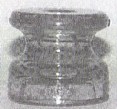
The next six pages show insulators for low voltage installations. The first
of these is a series of small knobs ranging in size from just over an inch to
about 2-3/4" tall. Only one of these has been previously reported, the CD 1082 embossed EV
// PH.40. Previously, the meaning of the "EV" was
unknown. I now assume that it is an abbreviation for L'Electro Verre. The
"PH" stands for "poulie haute," or "tall pulley," and "40" is the height in
millimeters. Unreported are this same shape in heights of 30, 35, 50, and 70
millimeters.
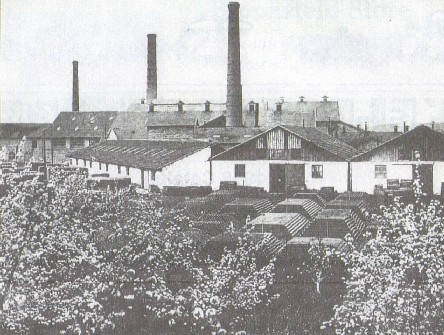
The next insulator shown is totally unknown to us, and would be a great find.
This spool insulator has a covering skirt on top, similar to the CD 1070, but
also has a flared skirt on bottom, with two arms like the "gingerbread
men." This is a rather small insulator, about 2" tall by 2-3/8"
in diameter, and weighing a mere 5.5 ounces.
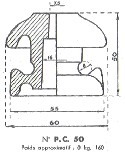
Next in the catalog is a series of five different sizes of
"flat pulley." Other European manufacturers made similar insulators,
such as the CD 1063 by Esperanza, SA of Spain, and the CD 1063.5 by Folembray
reported in the April, 2000 issue of CJ. None of these L'Electro Verre
"pulleys" are known at this time.
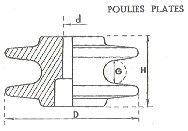
There are two pages of two- and three-wire cleats, and two styles of strains
(none of which have been reported). Wire cleats are quite common in porcelain,
but I have never heard of one in glass. Then we see a "secondary line
aerial fuse insulator.'

This strain insulator is known but does not have an assigned CD number. It
comes in at least two sizes - the one (pictured on the right) is an unembossed
unit about 5" long. The catalog includes a diagram showing how the
insulators are used.
The two illustrations (below) show the configuration for all-aluminum wire on
the left, and a combination of copper and aluminum wire on the right. These
"isolateurs a coupe-circuit" are fuseholders.
"Coupe-circuit" literally means "cut-circuit," but this is
better translated as "fuse." The two holes through the glass hold terminals,
one end of which is attached to the main line, and the other end is attached to
a fuse wire. This is similar to how all the fuseholder styles of insulators,
such as the "cockscombs," were wired. The catalog lists this strain
insulator in two main sizes, with a minor variation in the larger on the size of
the holes to hold the terminals.
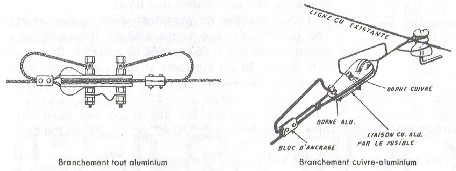
There is then one page for telephone line insulators,
depicting the familiar CD 640 and 642 "gingerbread
men." The catalog describes these as "eared" insulators.
The next six pages are dedicated to low voltage styles. The
"double bell and split head" insulators (shown below) are
offered in four sizes, DC1 through DC4, corresponding to CDs 574, 575, 576, and 577.1.

All of these have
been reported, though the catalog also lists the old style numbers of 21, 22,
23, 24, and 25, none of which are known L'Electro Verre embossings. The
"DC" stands for "double cloche", which translates as
"double bell," or what we would call "double petticoat."
A series of three sizes of "tall collar" insulators .(shown below) are CDs 535,
536, 537, and 537.2. These are style numbers HC 63, HC 64,
and HC 65, or old styles 43, 44, and 45.
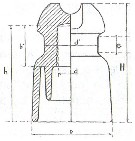
CD 537 has only been reported with an
embossing of "EIV HC 65", not embossed L'Electro Verre; nor has any number 44
embossing been reported. The "HC" stands for "haut collet",
meaning "tall collar", undoubtedly referring to the high, wide, side
groove on these insulators.
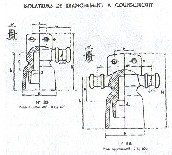
The
following three pages depict what we call "nosers" and
"t-bars": CDs 666, 667, 675 and 679, all of which
are known to the hobby, as well as two insulators that are
recent discoveries. These are a combination of fuse holder and arms. Insulators with one or two arms, and insulators with fuseholders, have been known for a long time. Two two-armed
combination of these styles, CDs 687 and 688, were brought back
to the U.S. in 1983. Ever since I had wondered if there were any
versions with only one arm. Several of these styles have been found since the
GIFONA Price Guide was released in 1996, including the illustrated one-armed
fuseholder (see CJ October, 1996; June, 1997; December 1998; and October, 1999).
The two-armed fuseholder described, at 5" tall by 3" wide, does not
match the size of any previously reported specimen.
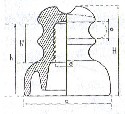
Finally, for the low voltage insulators, are three sizes of insulators with
fuseholders (but no arms), and two sizes of a loop insulator for aluminum wires
(shown above). The "cockscomb" style numbers 93, 96, 98 and 99
correspond to CDs 654.1, 657 (or 656.5), and 656. Style numbers 98 and 99 are
the same shape, with a minor variation in the diameter of the holes to hold
the fuse terminals. The loop insulators are style numbers 34 and 35, CDs 251.7
and 251.8. Style number 35 has not been reported, but this shape has been found
embossed "L'Electro Verre" on the front, with "DC 22" or
"DG 22" on the back.

At the end of the catalog are three pages of miscellaneous
insulators, all spools. We see the familiar double-groove dead-end
spools A 21 and A 22 (CDs 1065 and 1066), but also
a larger A 23 that has not been reported. The "A"
stands for "arret" or "stop", better translated as dead-end.
Also shown are the similar, but less familiar, single groove 171 and 173
(CDs 1067 or 1067.1 and 1069). Number 157 is the same type of single wire groove
spool, but in a much larger size. This massive 7 _" x 7 _" dead end spool
weighs in at just over 9 pounds, 2 ounces. Imagine trying to fit that in your
suitcase!
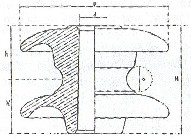
Last shown is an intriguing variation similar to CD 1066. The glass
extension on the side is a fuseholder, similar to the top ridge on the
"cockscomb" insulators. The two ridges across the top are also
different from the normal CD 1066. This one has never been reported, and would
be a great find.
A typewritten price list, dated March 1, 1948, also survives and gives us
more information about the insulators. The December, 1996 CJ Foreign Insulator
column showed a 4.piece "behemoth" power insulator produced by
Folembray. The L'Electro Verre price list
mentions three styles of similar four-piece insulators, ranging in size up
to 14-3/8" x 15-3/8". I'm not sure where that measurement is taken for
the width, and unfortunately it is not pictured in the catalog, but that's a big
piece of glass!
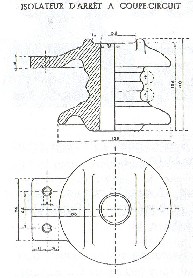
And, finally, the October, 1999 CJ reported the new CD 485, the L'Electro Verre 147. - This insulator, although not in the catalog, is listed
in the price guide. It is in a section for "Isolateurs Type
'Traction"', or "'Traction' Type Insulators". I'm not positive of
the precise meaning behind "traction" - my French dictionary defines
it as the "action of pulling". This particular insulator is "pour
support de trolley", or part of the assembly for the distribution of power
from an overhead conductor to an electric train or trolley.
Next time that you are in France, keep a lookout for some of these unreported
insulators. If you find any, please let us know!
Due to the size of the catalog, we have only summarized some of the
information here. For those with a desire to see more, you may visit
http://www.insulators.com/catalogs/lelectroverre/1948/ to see the entire
catalog.
|
